Topic outline
- General
- Welcome and introduction


With most of the youth (and adults) being constantly glued to their mobile phones checking out their latest social media updates, we, as teachers, need to think of innovative ways in which we can incorporate the use of social media into the classroom. However, before we can incorporate the use of social media into teaching, we need to acquire the skill in using it ourselves! We hope that, by the end of this unit, you will have some ideas on how to do just that! Review the video below that looks at some potential benefits of social media for teaching and learning.

By the end of this unit, you should have an understanding of:
- The different types of social media platforms which are available
- How to effectively incorporate the use of social media into your classroom.
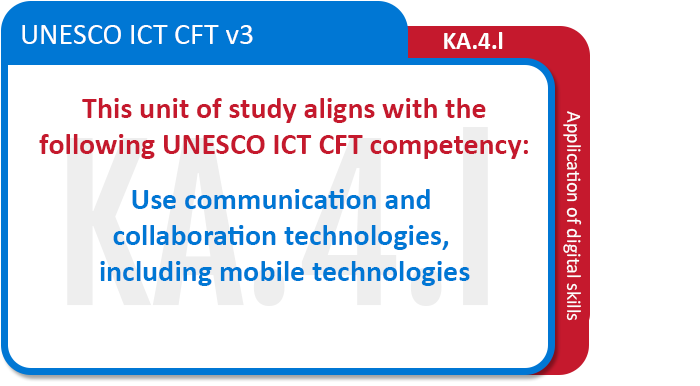
- What is social media?

Before we embark on our journey of how to use social media in the classroom, let's first get a very clear understanding on what social media actually is. Review the video below (on YouTube - a social media platform in its own right):
An explanation of what social media is
A social networking website is known by many different names. You might have heard people use terms like “social networks”, ”social media”, “online communities” or “social networking sites”. All of these terms essentially mean the same thing: An online community is a social networking website where people are able to communicate with other people that they know such as family and friends, as well as organizations and the rest of the world.
People can communicate on social networks in a variety of ways, they can send text messages to one another, find and connect with friends, share photos, videos, thoughts, and articles from other websites, create and post their own photos, videos and join online communities where people have the same interests.




The list of social media applications is extensive but for the purposes of keeping within our allocated time for this study unit, we will focus on Facebook, WhatsApp, Google Meet and Google Chat (previously known as Google Hangouts) Please explore the other popular platforms like Twitter, Instagram and Pinterest since you may feel more comfortable using these platforms in your classroom.
- Getting started with Facebook


Facebook is the world's largest social networking site. It provides users with the online facility to connect and share with friends and family around the world. On Facebook you can:
- Find friends and add them so that you can see their profiles
- Find and follow organisations, celebrities, politicians and groups that you are interested in
- Create groups that consist of certain people, such as your class, other teachers, or parents from your school
- Create your own Facebook profile which has your name, picture, and details about you
- Create a Facebook page for an organisation or an interest that you have. For example, you can create a Facebook page for your school or your class.
Review the resource below to find out more!
- Find friends and add them so that you can see their profiles

Now that you have a clear understanding of what Facebook actually is, let's take the first step on how to start using Facebook. This will involve setting up an account on Facebook.
Review the video below on how to set up a Facebook account.

Often when we create a new account we don't always understand all the settings. A while later we may realise that we'd like to modify some of these settings. Review this useful tutorial to find out how to do this.
- Some Facebook features

Now that you have created a Facebook account, let's explore some of the features which Facebook offers us.

Facebook provides the platform to share comments, photos and videos online - these are called 'posts'. When you share a post, all your Facebook friends will see your post. They are then able to comment on your post and so the interaction begins.
Review the tutorial below on how to share on Facebook:

Sometimes you may want to communicate privately with your Facebook friend(s). Chats and messages allows you to have a private communication with friends - this communication is not shared with all of your friends and does not appear on your timeline.
To find out more on how to use Facebook chats and messages, look at the resource below.
Maybe you'd like to create a Facebook group for a specific class or subject or create a Facebook page dedicated to a class or subject? By creating such a group you'd be able to notify learners as a group as opposed to doing individual notifications. Let's see how to do this:
There are many more features available in Facebook which you may feel can be used within the teaching environment. We encourage you to further explore this social media platform and to also review the resources listed both under 'Attributions' and 'References' below.
Posting on Facebook reaches all your contacts, and often your contact's contacts, so it is advisable to follow these guidelines when interacting on, actually, any social media platform:
- Don't express offensive views
- Only accept friend requests of people that you know!
- Comment on posts only when you have something constructive to say
- If somebody comments on your post with an offensive or disagreeable view point, you are able to delete the post. Generally it is advisable not to engage with them by responding to their post
- Remember that Facebook gives you access to peoples' lives. It is important to behave responsibly with that information by not sharing things that they post unless you are sure that they would be agreeable to this.
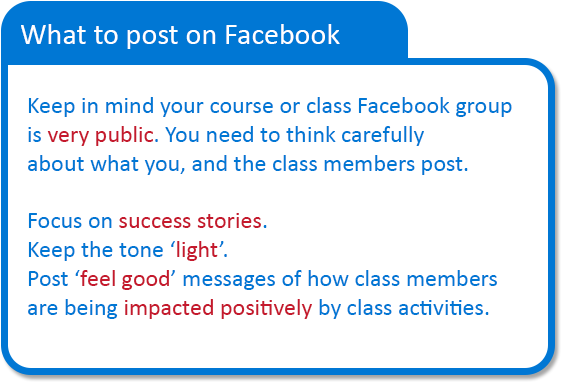
- Facebook privacy settings

Understanding Facebook privacy
It is extremely important that you understand the privacy settings on Facebook. Should you choose to share e.g. photos publicly on Facebook, this means that everybody (not only your friends) is able to see this information. Ensure that your posts are just shared privately (i.e. with your friends). It is also advisable not to share personal information like your contact numbers and physical address on Facebook. Third party persons and web sites are able to access public Facebook information so ensure that you check your privacy settings before proceeding.
Review the tutorial below on understanding Facebook's privacy settings.
To make it easy for you, follow this step by step process to ensure your online privacy on Facebook:- Generally, you should only accept friend requests from people that you know
- Only provide information on Facebook that you are comfortable with your friends knowing
- The 'privacy settings' on Facebook will allow you to decide how much information people can see, you can access this by clicking on this arrow:
- On the left side of the page, click here:
- Now you are able to change your settings.
- Generally, you should only accept friend requests from people that you know
- WhatsApp

What is WhatsApp?
WhatsApp, owned by Facebook, is a free instant messaging service that can be downloaded onto your SmartPhone. Using WhatsApp enables you to send private text messages and multimedia e.g. photos and videos, send voice messages as well as making voice calls to your contacts. WhatsApp is able to do this by using your phone's internet connection or the WiFi which you are connected to.
Getting started with WhatsApp
Review the tutorial below to find out how to access and download WhatsApp.
- Some WhatsApp features


There are some great benefits of using a messaging platform like WhatsApp to support communication between class participants. Firstly it is immediate! It can be used to send alerts and messages quickly to class participants. They are more likely to see it than e-mail messages or messages sent from within a learning management system (LMS). Sending a text messages using WhatsApp is also free - that is one of the reasons why WhatsApp is so popular!

One of the useful features that WhatsApp offers is the facility to create a group. Some examples of how you could use this in your teaching environment is to:
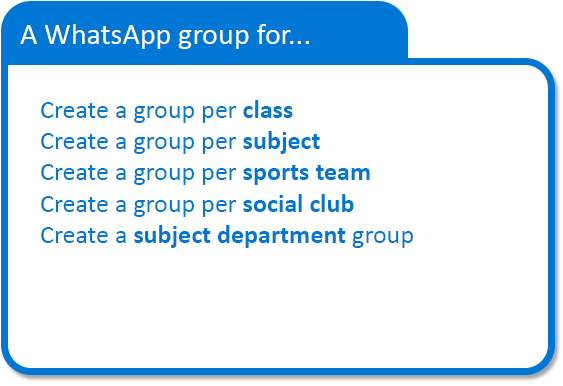
I'm sure that you could think of many others opportunities where you could use a group in WhatsApp. The advantage of creating a group is that, once you add all the relevant contacts into the group, you then just send one message and all the contacts in that group receive the message. All the contacts can reply accordingly.
Have a look at the instructions on how to create a group:
- Open WhatsApp and go to 'Chats'
- At the top of the 'Chats' screen, select the 'New Group' button
- Add people to the group by selecting them or by typing their name into the search bar
- Type in a name for the group e.g. Class 10
- You can add a profile picture to the group should you wish to
- When you have typed in the details, click on 'Create'.
Access the video below to see these steps in action.

Another advantage of using WhatsApp is that you are able to make free voice calls - and this includes voice calls to international numbers!

It's always wise to understand both sides of the story and when it comes to social media, it is especially so!
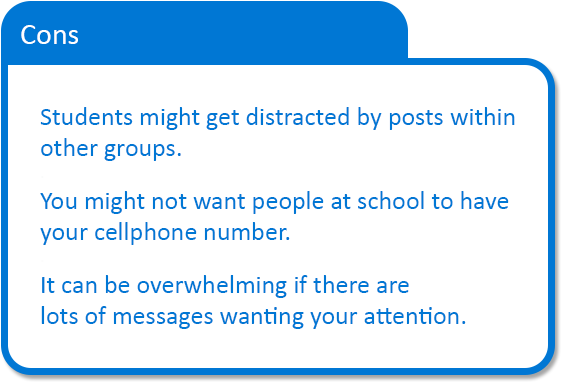
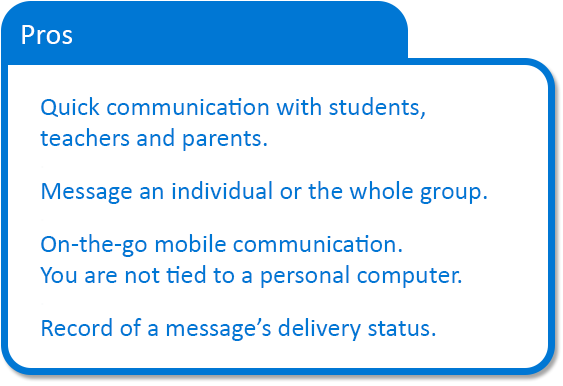


- Be respectful and courteous: always treat people with respect
- Keep the topic relevant: do not discuss subjects that have nothing to do with why the group was created
- Keep the group in mind: if you want to have a conversation with someone in particular, send them a message separately
- Make sure not to interact too much on the group, this can be irritating to other group members.
- Google Meet and Google Chat

Alternative social media options
Not a fan of the social media tools mentioned above then consider this alternative? Google Hangouts has recently evolved into two services viz.:
- Google Chat: for messaging
- Google Meet: for video and audio meetings
These products are a free service that Google offers which provides you with the platform to make phone calls, text and video conference to anyone in the world! These applications can operate both on your mobile device and your desktop computer. So let's find out a little more...
- Global Education Coalition (GEC)

The following enrichment resources have been made available by GEC members:
- Social media in the classroom

Before participating in the group discussion, review these three YouTube videos on the importance of using, and how to use, social media in education. These videos will hopefully trigger some ideas on how you can incorporate social media into your lesson plans and teaching.

Having reviewed some of the functionality on offer from Facebook, WhatsApp, Google Meet and Google Chat, access the forum discussion tool below and:
- Discuss how Facebook, WhatsApp, Google Meet and Google Chat can be used effectively in the teaching environment
- Discuss other social media platforms which you feel would benefit learning in the classroom.
Everyone needs to post at least two comments and two replies per forum thread.
- Conclusion, attribution and licence


With social media having revolutionised both business and personal interactions and communications, it is essential that we, as teachers, have the necessary skills on how to use social media effectively both in the classroom and out. It is important to remember that with the advantages of social media come the disadvantages and it is critical that you are aware of both.
We trust that this course exposed you to some of the social network platforms out there and we encourage you to explore other popular social media networks.

The following openly licensed resources were adapted to create this unit of study:

The following resources were consulted in this study unit. Full copyright but free to use:

ICT Essentials for Teachers by UNESCO is licensed under a Creative Commons Attribution-ShareAlike 4.0 International License.
All content not licensed under a Creative Commons licence is all rights reserved, and you must request permission from the copyright owner to use this material.
1
2
3
4
5
6
7
8
9
10
11
